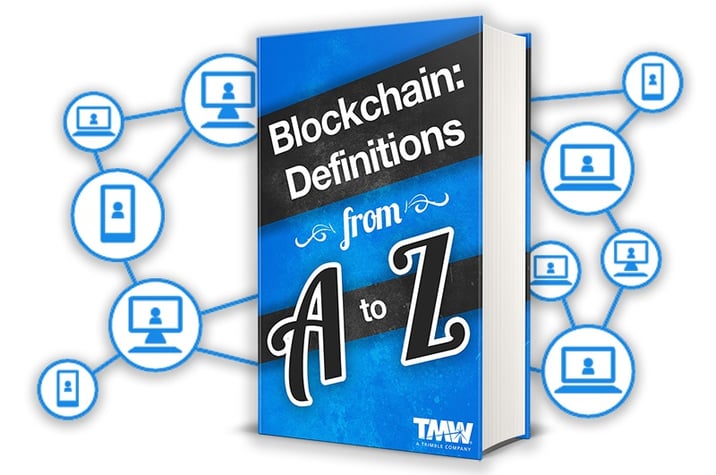Blockchain technology is expected to have a tremendous impact on the transportation industry. To understand its basics and potential, begin with Timothy Leonard’s expansive white paper, “Blockchain for Transportation: Where the Future Starts,” then check out our blog post Blockchain Technology: The 21st Century Link For Profit and Growth and pre-recorded webinar. For further help in learning the language of blockchain, we’ve compiled an A-to-Z glossary from multiple sources defining the most common terms related to Blockchain.

Address
Blockchain addresses are used to send or receive transactions on the network. An address usually presents itself as a string of alphanumeric characters.
Bitcoin
Bitcoin is the first decentralized, open source cryptocurrency that runs on a global peer-to-peer network, without the need for middlemen and a centralized issuer.
Block
Blocks are packages of data that carry permanently recorded data on the blockchain network.
Blockchain
A Blockchain is a shared ledger where transactions are permanently recorded by appending blocks. The blockchain serves as a historical record of all transactions that ever occurred, from the genesis block to the latest block, hence the name blockchain.
Block Explorer
Block explorer is an online tool to view all transactions, past and current, on the blockchain.
Block Height
The number of blocks connected on the blockchain.
Block Reward
A form of incentive for the participant (called a miner) who successfully calculated the hash in a block during mining. Verification of transactions on the blockchain generates new coins or tokens in the process, and the miner is rewarded a portion of those.
Confirmation
The successful act of hashing a transaction and adding it to the blockchain.
Consensus
Consensus is achieved when all participants of the network agree on the validity of the transactions, ensuring that the ledgers are exact copies of each other.
Cryptocurrency
Also known as tokens, cryptocurrencies are representations of digital assets. While Bitcoin is one of the most widely recognizable names, there are more than 900 cryptocurrencies in use.
Cryptography
Mathematics creates codes and ciphers to conceal information. Used as the basis for the mathematical problems used to verify and secure transactions on the blockchain.
Dapp
A decentralized application (Dapp) that is open source, operates autonomously, has its data stored on a blockchain, incentivized in the form of cryptographic tokens and operates on a protocol that shows proof of value.
Distributed Ledger
Distributed ledgers are databases storing data across a network of decentralized nodes. A distributed ledger does not have to have its own currency and may be permissioned and private.
Distributed Network
A type of network where processing power and data are spread over the nodes rather than having a centralized data center.
Digital Signature
A digital code generated by public key encryption that is attached to an electronically transmitted document to verify its contents and the sender’s identity.
Double Spending
Double spending occurs when a sum of money is spent more than once.
A blockchain-based decentralized platform for apps that run smart contracts, and is aimed at solving issues associated with censorship, fraud and third-party interference.
Genesis Block
The first or first few blocks of a blockchain.
Hash
The act of performing a hash function on the output data. This is used for confirming coin transactions.
Hash Rate
Measurement of performance for the mining rig is expressed in hashes per second.
Mining
The act of validating blockchain transactions. The necessity of validation warrants an incentive for the miners, usually in the form of coins or tokens.
Multi-Signature
Multi-Signature--also known as multisig-- addresses provide an added layer of security by requiring more than one key to authorize a transaction.
Node
A copy of the ledger operated by a participant of the blockchain network.
Peer to Peer
Peer to Peer (P2P) refers to the decentralized interactions between two parties or more in a highly-interconnected network. Participants of a P2P network deal directly with each other through a single mediation point.
Public Address
A public address is the cryptographic hash of a public key. They act as email addresses that can be published anywhere, unlike private keys.
Private Key
A private key is a string of data that allows you to access the tokens in a specific wallet. Private keys, also known as secret keys, act as passwords that are kept hidden from anyone but the owner of the address.
A consensus distribution algorithm that rewards earnings based on the number of coins you own or hold. The more you invest in the coin, the more you gain by mining with this protocol.
Proof of Work
A consensus distribution algorithm that requires an active role in mining data blocks, often consuming resources, such as electricity. The more ‘work’ you do or the more computational power you provide, the more coins are rewarded.
Smart Contracts
Smart contracts encode business rules in a programmable language onto the blockchain and are enforced by the participants of the network.
Solidity
Solidity is Ethereum’s programming language for developing smart contracts.
Testnet
A test blockchain used by developers to prevent expending assets on the main chain.
Transaction Block
A collection of transactions gathered into a block that can then be hashed and added to the blockchain.
Transaction Fee
All cryptocurrency transactions involve a small transaction fee. These transaction fees add up to account for the block reward that a miner receives when he successfully processes a block.
Wallet
A file that houses private keys. It usually contains a software client which allows access to view and create transactions on a specific blockchain that the wallet is designed for. There are two main types of wallets: software and hardware. A software wallet is one that you install on your own computer or mobile device. A hardware wallet stores private keys on a secure hardware device.


